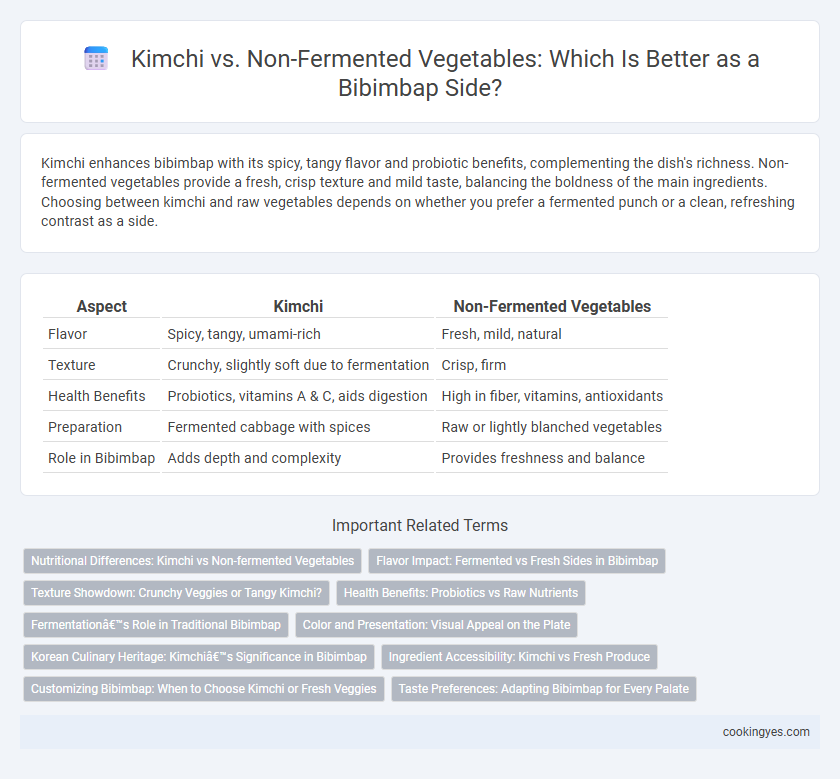Kimchi enhances bibimbap with its spicy, tangy flavor and probiotic benefits, complementing the dish's richness. Non-fermented vegetables provide a fresh, crisp texture and mild taste, balancing the boldness of the main ingredients. Choosing between kimchi and raw vegetables depends on whether you prefer a fermented punch or a clean, refreshing contrast as a side.
Table of Comparison
| Aspect | Kimchi | Non-Fermented Vegetables |
|---|---|---|
| Flavor | Spicy, tangy, umami-rich | Fresh, mild, natural |
| Texture | Crunchy, slightly soft due to fermentation | Crisp, firm |
| Health Benefits | Probiotics, vitamins A & C, aids digestion | High in fiber, vitamins, antioxidants |
| Preparation | Fermented cabbage with spices | Raw or lightly blanched vegetables |
| Role in Bibimbap | Adds depth and complexity | Provides freshness and balance |
Nutritional Differences: Kimchi vs Non-fermented Vegetables
Kimchi, a staple Korean fermented side dish, offers enhanced probiotic benefits and increased vitamin C content compared to non-fermented vegetables commonly served with bibimbap. Non-fermented vegetables retain higher levels of certain heat-sensitive nutrients like vitamin A and folate but lack the gut-health promoting lactobacilli found in kimchi. Incorporating kimchi into bibimbap not only enriches the dish's flavor profile but also delivers unique fermented nutrients that support digestion and immune function.
Flavor Impact: Fermented vs Fresh Sides in Bibimbap
Kimchi offers a tangy, spicy kick that enhances Bibimbap's complex flavors through fermentation, introducing probiotics and depth that fresh vegetables lack. Non-fermented vegetables provide a crisp, clean freshness that balances Bibimbap's rich gochujang and sesame oil without overpowering their taste. The choice between kimchi and fresh sides ultimately shifts the flavor profile from sharp and umami-rich to light and refreshing, tailoring the overall dining experience.
Texture Showdown: Crunchy Veggies or Tangy Kimchi?
Bibimbap pairs perfectly with either crunchy non-fermented vegetables like julienned carrots and cucumbers or tangy kimchi, each offering distinct textural contrasts. The crispness of fresh vegetables provides a clean, refreshing bite that balances the warm rice and savory toppings, while kimchi delivers a spicy, chewy punch with its fermented depth. Texture plays a vital role in enhancing the overall sensory experience, making the choice between crunchy veggies and tangy kimchi a key factor in personalizing bibimbap's flavor profile.
Health Benefits: Probiotics vs Raw Nutrients
Kimchi serves as a probiotic powerhouse in bibimbap, enhancing gut health and digestion through its beneficial live bacteria. Non-fermented vegetables, such as spinach and cucumbers, provide a rich supply of raw nutrients, including vitamins C and K, antioxidants, and fiber essential for immune support and detoxification. Choosing between kimchi and fresh vegetables depends on whether the goal is to boost gut microbiota with probiotics or to maximize intake of heat-sensitive vitamins and antioxidants.
Fermentation’s Role in Traditional Bibimbap
Fermentation in kimchi enhances the flavor complexity and nutritional value of bibimbap by introducing probiotics that aid digestion and boost gut health. Non-fermented vegetables provide fresh, crisp textures and retain natural vitamins without the tangy sourness characteristic of fermented foods. Traditional bibimbap balances the rich umami of fermented kimchi with the vibrant freshness of raw vegetables, creating a harmonious blend that supports both taste and digestive wellness.
Color and Presentation: Visual Appeal on the Plate
Kimchi's vibrant red hues enhance bibimbap's colorful presentation, creating a striking contrast against white rice and green vegetables. Non-fermented vegetables like spinach or zucchini provide fresh green and pale tones that balance the dish's palette with a natural, crisp look. Combining both can elevate the visual appeal by layering warm and cool colors that stimulate appetite and highlight the dish's diverse textures.
Korean Culinary Heritage: Kimchi’s Significance in Bibimbap
Kimchi, a fermented vegetable staple rich in probiotics and vitamins, is deeply embedded in Korean culinary heritage and significantly enhances bibimbap with its tangy umami flavor and digestive benefits. Non-fermented vegetables used in bibimbap provide fresh, crisp textures and mild flavors but lack the complex fermentation-derived health properties that kimchi offers. The inclusion of kimchi not only amplifies the traditional authenticity of bibimbap but also reflects Korea's cultural emphasis on fermentation as a healthful preservation method.
Ingredient Accessibility: Kimchi vs Fresh Produce
Kimchi offers a convenient and readily available side for bibimbap due to its long shelf life and widespread production, making it accessible year-round. Fresh non-fermented vegetables require regular access to local markets and seasonal availability, impacting ingredient accessibility depending on the region. Choosing between kimchi and fresh produce as banchan for bibimbap often depends on convenience and the freshness of ingredients in a given locale.
Customizing Bibimbap: When to Choose Kimchi or Fresh Veggies
Kimchi enhances bibimbap with its bold, fermented flavors and probiotic benefits, ideal for those seeking a spicy, tangy kick. Fresh, non-fermented vegetables provide a crisp, mild contrast that highlights the dish's natural textures and balances richer ingredients. Choosing kimchi or fresh veggies depends on desired taste intensity and nutritional preferences, customizing bibimbap to individual flavor and health goals.
Taste Preferences: Adapting Bibimbap for Every Palate
Kimchi offers a spicy, tangy contrast that enhances the traditional Bibimbap experience, delivering a punch of fermented umami that complements the savory rice and vegetables. Non-fermented vegetables like fresh cucumbers or blanched spinach provide a mild, crisp texture, appealing to those who prefer a lighter, fresher taste profile. Choosing between kimchi and non-fermented sides allows customization of Bibimbap to suit diverse flavor preferences, balancing boldness and subtlety for every palate.
Kimchi vs Non-fermented Vegetables for Bibimbap Side Infographic

 cookingyes.com
cookingyes.com